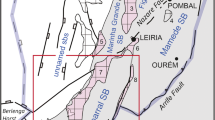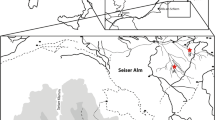Summary
The Arctic Vesterisbanken Seamount, situated far offshore in the central Greenland Sea, provides a unique facility for studing modern cold water siliceous carbonate deposits. A nearly year round sea ice cover, which retreats on average only during two months, and a rather constant temperature and salinity structure of the water column characterize the Arctic conditions of the area.
Despite predominantly oligotrophic conditions with a pronounced food supply from the pelagic realm only during the ice-free season, the seamount is covered extensively by extended sponge-bryozoan constructions. Three distinct facies belts reveal a pronounced depth zonation which depends on variations in downslope food transfer and which is specifically effective due to the development of aTaylor current regime over the seamount: i) the crest facies from the summit at −133m to −260 m, ii) the shallow slope facies from −260 m to −400 m, iii) the deep slope facies from −400 m down to the abyssal plain at about— 3.000 m. Different biogenic structures and communities are found within these facies belts, including widely extended biogenic mats, sponge bryozoan-serpulid buildups with mounds, hedges, spurs and flatcake-like structures, bryozoan thickets and sponge-crinoid mounds. Depth zonation, internal structure and controlling parameters in the formation of these biogenic structures are discussed in the context of their significance as a modern end member of the Foramol facies and their implication for the fossil record. In addition, the younger volcanic and hydrothermal history of the seamount is presented with special reference to its bearing on Holocene biogenic colonization patterns.
Similar content being viewed by others
References
Altenbach, A. V., Unsöld, G. &Walger, E. (1987): The hydrodynamic environment ofSaccorhiza ramosa.—Ber. Sonderforschungsber. 313,6, 47–68, Kiel.
Armauer Hansen, G. (1885): Spongiadae.—The Norwegian North-Atlantic Expeditions 1876–1878,13 (Zoology), 25 pp., Christiania (Leipzig)
Augstein, E., Hempel, G., Schwarz, G., Thiede, J. & Weigel, W. (1984): Die Expedition ARKTIS II des FS “Polarstern” 1984. —Ber. Polarforschung,20, 192 pp., Bremerhaven
Bernhard, F. R. (1979): Bivalve molluscs of the western Beaufort Sea.—Contr. Sci.,313, 80 pp, Los Angeles
Boehlert, G. W. (1987): A review of the effects of seamounts on biological processes.—In:Keating, B. H., Fryer, P., Batiza, R. & Boehlert, G. W. (eds.): Seamounts, Islands and Atolls, Geophysical Monographs,43, 319–333, Washington
Breitfuss, L. L. (1898): Die arctische Kalkschwammfauna.— Arch.f.Naturgesch., 277–316, Berlin
Brönstedt, H. V. (1914): Porifera—Conspectus Faunae Groenlandicae. —Meddl. om Grønland,23, 459–544, Kopenhagen
Bullivant, J. S. & Dearborn, J. H. (1967): The fauna of the Ross Sea, Pt. 5.—New Zealand Dept. Scient. Industr. Res. Bull.,176, 76 pp, Wellington
Burton, M. (1934): Zoological results of the Norwegian scientific expeditions to East-Greenland. III. Report on the sponges of the Norwegian expeditons to East-Greenland (1930, 1931, and 1932).—Skrifter om Svalbard og Ishavet,61, 33 pp., Oslo
Burton, M. (1959): Spongia.—The Zoology of Island,2 (Part 3–4), 71 pp., Kopenhagen & Reykjavik
Clark, A. H. (1970): Echinodermata Crinoidea.—Marine Invertebrates of Scandinavia,3, 55pp., Oslo
Eggvin, J. (1963): Bathymetric chart of the Norwegian Sea and adjacent areas. Scale 1∶5.000.000.—Fiskeridir. Havforskingsinst., Bergen
Eldholm, O. &Thiede, J. (1980): Cenozoic continental separation between Europe and Greenland.—Palaeogeogr., Palaeoclimatol., Palaeoecol.,30, 243–259, Amsterdam
Fairbanks, R. G. (1989): A 17.000 year glacio-eustatic sea level record: influence of glacial melting rates on the Younger Dryas event and deep ocean circulation.—Nature,143, 637–642, London
Fristedt, K. (1885): Bidrag till Kännedomen om de vid Sveriges vestra kust lefvande Spongiae.— Kongl. Svenska Vetenskaps-Akad. Handl.,21/6, 56 pp., Stockholm
Graf, G. (1989): Benthic-pelagic coupling in the deep-sea benthic community.—Nature,341, 437–439, London
Gulliksen, B., Haug, T. &Sandnes, K. (1980): Benthic macrofauna on new and old lava grounds at Jan Mayen.—Sarsia,65, 137–148, Bergen
Harmelin, J.-G. (1975): Relation entre la forme zoariale et l’habitat chez les bryozoaires cyclostomes et consèquences taxonomique. Docum. Lab. Geol. Fac. Sci. Lyon (hors Ser.)3 (Bryozoa 1974), 369–384, Lyon
Hartmann, M., Lass, H. & Puteanus, D. (1989): A new method for trace metal determination in seawater.—In:Welz, B. (ed.): 5. Colloquium Atomspektrometrische Spurenanalytik, 703–709
Hayward, P. J. &Ryland, J. S. (1979): British Ascophoran bryozoans.—In:Kermack, D. M. &Barnes, R.S.K. (eds.), Synopsis of the British Fauna (n. s.),14, 1–312, Academic Press, London
Hempel, P., Schreiber, R., Johnson, L. &Thiede, J. (1991): The Vesterisbanken Seamount (Greenland Basin)—patterns of morphology and sediment distribution.—Marine Geology96, 175–185, Amsterdam
Hentschel, E. (1916): Die Spongien des Eisfjordes.—Zool. Ergebn. der Schwedischen Expedition nach Spitzbergen 1908, TeilII (3), 18 pp., Stockholm
Hogg, N. G. (1973): On the stratifiedTaylor column.—J. Fluid Mechanics,58, 517–537, London
Hörmann, P. K. & Raase, P. (1991) Petrology of basalts from the Vesterisbanken (Greenland Sea).—Marine Geology (in press)
Huppert, H. E. (1975): Some remarks on the initiation of inertialTaylor columns,—J. Fluid Mechanics,67, 397–412, London
Johannessen, O.M. (1986): Brief overview of the physical oceanography.— In:Hurdle, B. G. (ed.), The Nordic Seas, 103–128, New York (Springer)
Kluge, G. A. (1975): Bryozoa of the northern seas of the USSR.— 711.pp., New Dehli (Amerind. Publishing Co.)
Koltun, V. M. (1959): Corneosiliceous sponges of the northern and far eastern seas of the USSR.—Keys for the identifications of the fauna of the USSR published by the Zoological Institute of the Academy of Sciences of the USSR, (Akad. NAUK USSR)67, 235 p., Moskow-Leningrad. (in Russian)
Koltun, V. M. (1964): Sponges from the Antarctic. 1. Tetraxonida and Cornacuspongida. In: Biological results of the Soviet Antarctic Expedition 1955/1958,2 Issled. Faunei Morei, 6–131, Moskow & Leningrad
Koltun, V. M. (1966): Four rayed sponges of the North and Far eastern Seas of the USSR (Order Tetraxonida).—Akad. NAUK USSR90, 107 pp., Moskow & Leningrad. (in Russian)
Koltun, V. M. (1967): Glass sponges of the Northern and Far Eastern Seas of the USSR.—Akad. NAUK USSR94, 124 pp., Moskow & Leningrad (in Russian)
—(1970): Sponges of the Arctic and the Antarctic: A faunistic review.—Sym. Zool. Soc. London,25, 285–297, London
Lambe, L. M. (1896): Sponges from the Atlantic Coast of Canada. —Trans. Roy. Soc. Can., Sec.6, 183–211, Montreal
— (1900): Catalogue of the recent marine sponges of Canada and Alaska.—Ottawa Naturalist,14/9, 153–172, Ottawa
Le Bas, M. J., Le Maitre, R. W., Streckeisen, A. &Zanettin, B. (1986): A chemical classification of volcanic rocks based on the total alkali-silica diagram.—J. Petrol.27, 745–750, Oxford
Lees, A. &Buller, A. T. (1972): Modern temperate-water and warm-water shelf carbonate sediments contrasted.—Marine Geology,13, M67-M73, Amsterdam
Lubinsky, I. (1980): marine bivalve molluscs of the Canadian central and eastern Arctic: Faunal composition and zoogeography. —Can. J. Fish. Aquat. Sci. Bull.,207, 1–111, Ottawa
Lundbeck, W. (1902): Porifera. Homorrhaphidae and Heterorrhaphidae, —The Danish Ingolf-Expedition,6/1, 105 pp., Hagerup (Kopenhagen)
— (1905): Porifera. Desmacidonidae (pars.).—The Danish Ingolf-Expedition,6/2, 219 pp., Hagerup (Kopenhagen)
— (1909): The Porifera of East Greenland.—Meddr. om Grønland,29, 423–464, Kopenhagen
— (1910): Desmacidonidae (pars.).—The Danish Ingolf-Expedition,6/3, 124 pp., Hagerup (Kopenhagen)
Lutze, G. F. &Altenbach, A. V. (1987):Rupertina stabilis (Wallich), eine hochangepaßte, filtrierende Benthos-Foraminifere. —Ber. Sonderforschungsber. 313,6, 31–46, Kiel
Marenzeller, E. (1886): Poriferen, Anthozoen, Ctenophoren und Würmer von Jan Mayen.—Die Österreichische Polarstation Jan Mayen, Beobacht. Ergeb.,3, 9–14, Wien
Merejkowsky, C. (1878): Les Éponges de la Mer Blanche.—Mem. Acad. Imper. Scienc. St. Petersbourg.—26/7, 7.Ser., 51 pp., St. Petersbourg
Nelson, C.S., Hydon, F.M., Keane, S.L., Leask, W.L. &Gordon, D.P. (1988): Application of bryozoan zoarial growth-form studies in facies analysis of non-tropical carbonate deposits in New Zealand.—Sed. Geology, 60, 301–322, Amsterdam
Nordgaard, O. (1918): Bryozoa from the Arctic Regions.—Tromsø Museum Årshefter,40/1, 1–99, Tromsø
Ockelmann, W.K. (1958): The zoology of east Greenland—marine Lamellibranchiata.—Meddr. om Grønland,107/7, 1–256, Kopenhagen
Oschmann, W. (1990): Dropstones—rocky mini-islands in high-latitude pelagic soft substrate environments.—Senckenbergiana marit.,21/1–4, 55–75, Frankfurt
Oschmann, W. (1991): Ecology and bathymetry of the Late Quaternary shelly macrobenthos from bathyal and abyssal areas of the Norwegian Sea.—Senckenbergiana marit.,21/5–6, Frankfurt
Piepenburg, D. (1988): Zur Zusammensetzung der Bodenfauna in der westlichen Fram Straße.—Ber. Polarforschung,52, 1–117, Bremerhaven
Powell, N.A. (1968): Bryozoa (Polyzoa) of Arctic Canada—J. Fish. Res. Bd. Canada,25/11, 2269–2320, Toronto
Rasmussen, B. N. (1965): On taxonomy and biology of the north Atlantic species of the asteroid genusHenricia Gray.—Medd. Danm. Fiskeri. Havunders. N.S.,4/7, 157–213, Kopenhagen
Ryland, J.S. (1963): Systematics and biological studies on Polyzoa (Bryozoa) from western Norway.—Sarsia,14, 1–59, Bergen
Schmitt, M., Botz, R. & Faber, E. (1991): Ultrasonic vacuun degassing of water for methane extraction.—Analytical Chemistry (in press)
Schopf, T. J. M. (1969): Paleoecology of ectoprocts (bryozoans), —J. Paleont.43, 234–244, Tulsa
Schulze, F.E. (1900): Die Hexactinelliden.—Fauna Arctica,1 (Lfg. 1), 86–108, Fischer, Jena
— (1903):Caulophacus arcticus (Armauer Hansen) undCalycosoma gracilem F.E. Sch. nov.spec.—Abh. K. preuss. Akad. Wiss.,1903, 1–22, Berlin
Stach, L. W. (1936): Correlation of zoarial growth form with habitat.—J. Geol.44, 60–66, Chicago
Steenstrup, E. &Tendal, O.S. (1982): The genusThenea (Porifera, Demospongia, Choristida) in the Norwegian Sea and adjacent waters; an annotated key.—Sarsia:67, 259–268, Bergen
Swift, J.H. (1986): The Arctic waters.—In:Hurdle, B.G. (ed.), The Nordic Seas, 129–154, Springer Verlag, New York
Taylor, G.I. (1923): Experiments on the motion of solid bodies in rotation fluids.—Proc. Roy. Soc. London, B., Biol. Sci.,104A, 213–218, London
Taylor, P.D. (1979): The inference extrazooidal feeding currents in fossil bryozoan colonies.—Lethaia,12, 47–56, Oslo
Tendal, O.S. (1970): Sponges from Jörgen Brönlund Fjord, North Greenland.—Meddr. om Grönland,184/7, 1–14, Kopenhagen
— (1979): Sponges of Jan Mayen.—Astarte,12, 53–55, Tromsø
Thiede, J. &Hempel, G. (1991): Die Expedition ARKTIS-VII/1 mit FS “Polarstern” 1990.—Ber. Polarforschung,80, 1–137, Bremerhaven
Thorson, G. (1958): The Godthaab expedition 1928: Scaphopoda, Placophora, Solenogastres, Gastropoda, Prosobranchia, Lamellibranchiata.— Medd. Grønland,81/2, 117pp, Kopenhagen
van Wagoner, N.A., Mudie, P.J., Cole, F.E. &Daborn, G. (1989): Siliceous sponge communities, biological zonation, and Recent sea-level change on the Arctic margin: Ice Island results.— Can. J. Earth Sci.,26, 2341–2355, Montreal
Vinje, T. (1985): The physical environment of the western Barents Sea: Drift, composition, morphology and distribution of the sea ice fields in the Barents Sea.—Norsk. Polarinst. Skr.,179C, 1–26, Oslo
Vosmaer, G. C. J. (1885): The Sponges of the “Willem Barents” Expedition 1880 and 1881.—Bijdr. Dierk.,12, 1–47, Amsterdam
Wallrabe-Adams, H. J. (1991): Submarine Aschelagen bei Vesterisbank (Grönlandsee).—IN:Thiede, J. & Hempel, G. (Hrsg.), Die Expedition ARKTIS-VII/1 mit FS “Polarstern” 1990, Ber. Polarforschung,80, 82–86, Bremerhaven
Winston, J. E. (1981): Feeding Behavior of Modern Bryozoans— IN:Broadhead, T.W. (ed.): Lophophorates, Notes for a short course. pp. 21, University of Tennessee, Cincinnati
— (1978): Polypide morphology and feeding behavior in marine ectoprocts—Bull. Mar. Sci.28, 1–31, Miami
Author information
Authors and Affiliations
Rights and permissions
About this article
Cite this article
Henrich, R., Hartmann, M., Reitner, J. et al. Facies belts and communities of the arctic Vesterisbanken Seamount (Central Greenland Sea). Facies 27, 71–103 (1992). https://doi.org/10.1007/BF02536805
Received:
Revised:
Issue Date:
DOI: https://doi.org/10.1007/BF02536805




